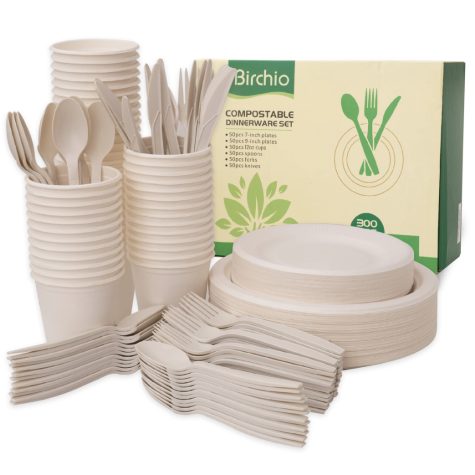The Most Wasteful Time of the Year
Nine ways to reduce your environmental impact this holiday season
The holiday season is probably the most wasteful time of year for Americans. A study by researchers at Stanford found that Americans throw away 25% more trash during the Thanksgiving to New Year’s holiday period than any other time of year. That is about 1 million extra tons per week.
In addition to material waste, America’s food waste skyrockets during this time. Usually, 30-40% of food supply is wasted. During the holidays though, this percentage jumps an additional 25%.
Brianna Baker, the president of the Environmental Club, said, “We need to make a change starting with our idea that it’s acceptable to waste so much on commercial holiday products.”
The holiday season can be detrimental to our environment, but many of us are wanting to make more sustainable shifts. Although waste is inevitable, there are ways that we can decrease it while still having joyful Christmas festivities. Baker said, “The change starts with you, and that change can come in the form of just understanding how much we waste and the changes we make to reduce it.” Here are a few simple ways:
1. Think outside of the box when wrapping presents.
Thousands of miles of wrapping paper are thrown away during the annual holiday season. Brianna Baker claims that, “wrapping paper and bows are something that can be easily substituted but aren’t.” Although tearing open presents constitutes my most favorite Christmas memories, the impact of this waste on the environment is ultimately not worth it. As a substitute for wrapping paper, Baker promotes creativity when wrapping this year. She suggests tote bags, newspapers, twine, and jars as substitutes, but you can also arrange things in baskets, wrap presents in paper bags or magazines, or simply skip the wrapping process altogether. You may be thinking, “Well, we recycle the paper.” The disheartening fact of the matter is that less than 9% of attempted recycling actually gets recycled. Oftentimes, iridescent and metallic wrapping papers are not even recyclable.
2. Skip the single-use plastic plates and utensils.
Straying from single-use plates and dining wear is certainly hard during the holidays. Although plastic wear reduces clean up and makes throwing parties easier, it contributes a large portion of material waste. In particular, plastic persists in the environment for thousands of years. With the vast majority of it ending up in landfills, it simply breaks down into smaller pieces and emits greenhouse gasses in the process. Instead, try opting for biodegradable and compostable plates and utensils made out of bamboo or sugar cane.
3. Try a vegan recipe!
Contrary to popular belief, there are tons of vegan recipes that mirror popular holiday dishes and taste amazing. By replacing a couple typical meat dish with a vegetarian or vegan option, you can lower your carbon footprint. Additionally, consuming less meat can conserve water, decrease waterway pollution, and reduce energy consumption. It all starts with just one meal.
4, Stop by a thrift store on your next holiday shopping trip.
Whether you need a hostess gift, Christmas presents, or a dinner outfit, try looking at a thrift store rather than buying it new. Buying things second-hand gives life to items that would have otherwise been thrown into landfill. Oftentimes, thrift stores and second hand shops have Christmas displays with sweaters, cooking equipment, decorations, and other great items! Although buying second hand gifts is normally looked down upon, incorporating them in with new items is crucial to reducing material waste.
5. Reusable bags > Single-Use bags.
Reusable bags are quite possibly the easiest way to reduce plastic and paper waste. Consider bringing reusable bags on your next shopping trip or grocery run. Some grocery stores such as Trader Joes or Whole Foods sell reusable bags at the checkout station, making it that much more convenient. You have the opportunity to save the environment and look stylish while doing so. To take it a step further, you can also bring smaller reusable bags for produce, instead of opting for the plastic ones offered in store. Ps. Reusable bags make great gifts!
6. Make decorations at home.
Not only is making gifts a great way to show appreciation for someone, it can be environmentally friendly. Many do-it-yourself decorations repurpose items you already have– such as the yarn and pompoms used to make garland shown below. Crafting decorations can also be a fun Christmas party activity, if you do not want to deal with the clean up after decorating cookies or gingerbread houses.
7. Gifts don’t have to be material items.
Experiences are gifts that people often don’t consider. Although concerts, amusement parks, or museum tickets fall under this category, there are other budget friendly options as well. One idea is giving someone ‘coupons’ for different activities like picnics, dinner, or movie nights that they can use in the future. This can reduce both material waste and carbon dioxide emissions.
8. Don’t throw away food- eat leftovers!
This one may be obvious, but super important and easy! Saving excess food from your dinner spread not only saves you time and money, but also reduces food waste. Oftentimes, meats, vegetables, and side dishes can be eaten up to four days after they’re prepared. It is also fun to repurpose leftovers into a new dish. On TikTok, many food content creators have repurposed Thanksgiving leftovers into delicious sandwiches–complete with cranberry sauce spread, turkey, a mashed potato layer, topped off with green beans.
9. Replace traditional lights with LED lights.
The first sustainable shift Brianna suggested was to replace electrical lights with LED lights. She says, “It’ll save you so much money on electricity bill and cut down your energy usage significantly.” LED lights have a longer lifespan, produce zero toxic elements and are up to 80% more efficient than regular fluorescent lights.
There are so many ways to reduce waste this Christmas. This year, try one or two if you can. Saving the planet requires all of us to step up and make some changes in the way celebrate the holidays.

Frankie Smith ‘23 is a new staff member of the Knight Magazine and the Knight Online. Before working on the Knight Magazine, Frankie anchored and created...











